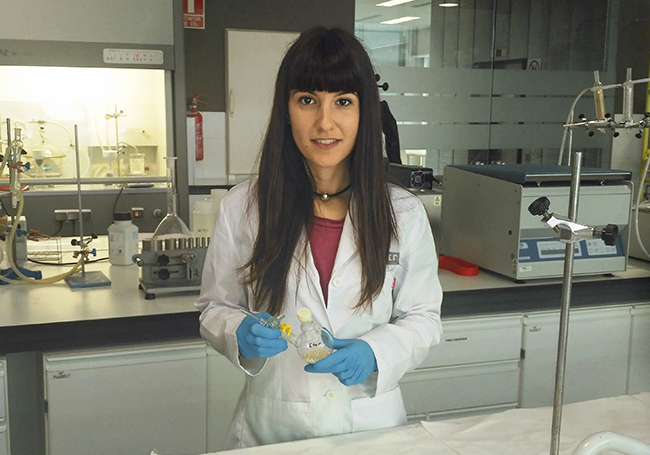La investigadora de la UPV/EHU Míriam Sáenz Pérez ha sintetizado varias fibras y tejidos a partir de poliuretanos con memoria de forma que promueven la evaporación del sudor y el control de la humedad, y además presentan una recuperación mayor del 99 %.
-

1.000 estudiantes se han reunido presencialmente con empresas que buscan talento joven
-

Jule Goikoetxea: «Si queremos nuevos sujetos, se debe incidir en las relaciones de poder que los crean»
-

Jornadas Puertas Abiertas
-

Ocho mujeres que cambiaron la farmacología
-

Nuevo equipo en la dirección de la Estación Marina de Plentzia PiE-UPV/EHU
Tejidos inteligentes gracias a materiales con memoria de forma
Un estudio de la UPV/EHU sintetiza poliuretanos con memoria de forma para la industria textil y del calzado
- Investigación
Fecha de primera publicación: 04/09/2018

La memoria de forma es una propiedad muy interesante que permite desarrollar materiales que pueden cambiar de forma cuando están sometidos a un estímulo externo (térmico, eléctrico, magnético, etc.). En los últimos años, los polímeros con memoria de forma han sido foco de atención debido a su destacada funcionalidad y a las posibilidades que ofrecen como materiales inteligentes. Entre ellos, “los poliuretanos con memoria de forma son una clase de polímeros que se pueden sintetizar con diferentes tipos de arquitecturas moleculares, mediante la variación de su composición y la elección adecuada de la estructura química de sus componentes. Esto da lugar a diversas aplicaciones en automoción, biomedicina, adhesivos, la industria textil o del calzado”, comenta Míriam Sáenz Pérez, investigadora del Departamento de Química Física de la UPV/EHU que actualmente trabaja en el Centro Tecnológico del Calzado de La Rioja.
Este trabajo se ha centrado en estudiar los poliuretanos con memoria de forma para aplicaciones en tejidos inteligentes. “El objetivo ha sido crear ciertas fibras o tejidos con memoria de forma; es decir, materiales que por sí solos son capaces de cambiar de forma y adaptarse a la situación en función de la temperatura a la cual se encuentran”, explica Míriam Sáenz. “Lo que realmente buscábamos era que su temperatura de transición vítrea —es un punto intermedio de temperatura entre el estado fundido y el estado rígido del polímero— fuera aproximadamente alrededor de 37-38 °C, es decir, similar a la temperatura corporal, y que el polímero pudiera modificar su forma en función de esa temperatura”, añade.
En primer lugar, se han sintetizado una serie de poliuretanos con segmentos rígidos y flexibles. A continuación, se ha analizado el comportamiento térmico, las propiedades mecánicas, la permeabilidad y el efecto de memoria de forma. Además, “se han creado fibras y tejidos a partir de estos poliuretanos con el fin de aportar una comprensión más profunda sobre los poliuretanos en la industria textil”, señala Sáenz.
“Los resultados obtenidos concluyen que los poliuretanos con memoria de forma sintetizados poseen aplicaciones prometedoras en la industria textil”, afirma la investigadora. Asimismo, “el efecto de memoria de forma demuestra que la mayoría de los poliuretanos con memoria de forma poseen valores de recuperación mayores del 99 %”. “Respecto a la permeabilidad —comenta Míriam Sáenz—, se ha observado que los films de poliuretano con memoria de forma poseen la capacidad de promover la evaporación del sudor y el control de la humedad”. También, “los poliuretanos con memoria de forma en forma de tejido presentan una recuperación mayor del 99 %, por lo que se puede concluir que las fibras y los tejidos se podrían usar en futuras aplicaciones en el campo textil”, concluye Miriam Sáenz.
Información complementaria
Esta investigación se ha llevado a cabo en el marco de la tesis doctoral de Míriam Sáenz Pérez (Logroño, 1986), titulada Shape memory polyurethanes. Applications in smart fabrics y dirigida por Luis Manuel León Isidro, catedrático de la UPV/EHU, y Jorge García Barrasa, especialista en innovación en Ecoembes. La tesis se ha realizado principalmente en el laboratorio de Química Macromolecular del Departamento de Química Física de la UPV/EHU y el Centro Tecnológico del Calzado de La Rioja donde se ha realizado la parte experimental. Además, se realizó una estancia predoctoral en la Universidad de Borås, Suecia.




